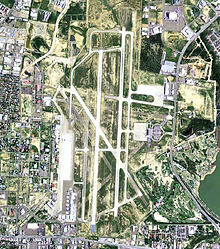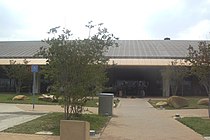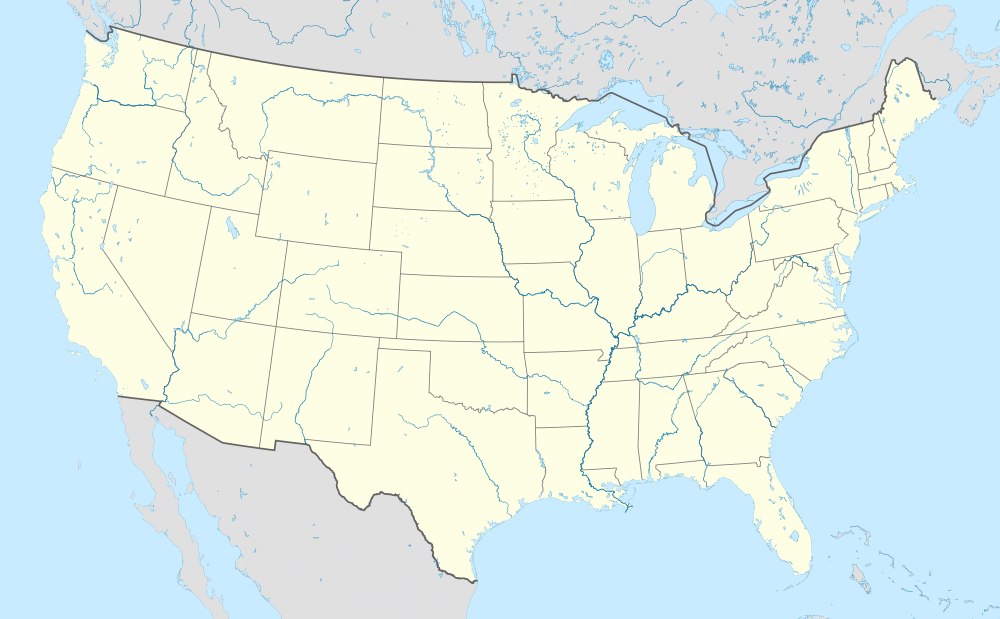Laredo International Airport
Laredo International Airport
Laredo International Airport | |||||||||||||||||||
|---|---|---|---|---|---|---|---|---|---|---|---|---|---|---|---|---|---|---|---|
 | |||||||||||||||||||
 USGS image 2006 | |||||||||||||||||||
| Summary | |||||||||||||||||||
| Airport type | Public | ||||||||||||||||||
| Owner | City of Laredo | ||||||||||||||||||
| Serves | Laredo, Texas | ||||||||||||||||||
| Elevation AMSL | 508 ft / 155 m | ||||||||||||||||||
| Coordinates | 27°32′38″N 99°27′42″W / 27.54389°N 99.46167°WCoordinates: 27°32′38″N 99°27′42″W / 27.54389°N 99.46167°W | ||||||||||||||||||
| Website | CityOfLaredo.com/... | ||||||||||||||||||
| Map | |||||||||||||||||||
| Runways | |||||||||||||||||||
| |||||||||||||||||||
| Statistics (2020) | |||||||||||||||||||
| |||||||||||||||||||
Laredo International Airport (IATA: LRD, ICAO: KLRD, FAA LID: LRD) is three miles northeast of downtown Laredo, in Webb County, Texas.[2]
The National Plan of Integrated Airport Systems for 2017–2021 categorized it as a non-hub primary commercial service airport. The airport sees four airlines with flights to Dallas, Houston, Las Vegas, Mexico City and Orlando. In the year ending December 2013, LRD had 102,856 passengers.[3] In 2012, LRD totaled 460,000,612 pounds of cargo.[4]
History[edit]
The Laredo International Airport was used by the United States Army Air Forces during World War II as Laredo Army Airfield, and by the United States Air Force as Laredo Air Force Base during the Cold War as a pilot training base with T-33 Shooting Star and later T-37 Tweet and T-38 Talon aircraft. The military presence ended in December 1973 as part of a nationwide defense cut back after the Vietnam War.[5]
At the entrance to the airport is the statue Among Friends There Are No Borders, designed by Armando Hinojosa of Laredo, which depicts a South Texas vaquero and a Mexican charro sharing a campfire.
Facilities[edit]
Laredo International Airport covers 1,796 acres (727 ha) at an elevation of 508 feet (155 m). It has three runways:[2]
- 18L/36R: 8,236 x 150 ft (2,510 x 46 m) Concrete
- 18R/36L: 8,743 x 150 ft (2,665 x 46 m) Concrete
- 14/32: 5,927 x 150 ft (1,807 x 46 m) Concrete
In the year ending September 30, 2018 the airport had 97,189 aircraft operations, an average of 266 per day: 41% military, 38% general aviation, 13% air taxi and 8% airline. In December 2019, 65 aircraft were based at this airport: 15 single-engine, 15 multi-engine, 20 jet and 15 helicopter.[2]
There is one, two-floor terminal at the Laredo International Airport. The bottom floor has the check-in counters, a gift shop, a restaurant, baggage carousel, rental car desks, and US customs. The airport's security checkpoint and four gates, all with jetways, are on the second floor. Free Wi-Fi internet access is available throughout the terminal. Gates 3 and 4 allow direct access to US customs. LRD sometimes receives diverted flights when severe weather threatens Dallas or Houston.
Airlines and destinations[edit]
Passenger[edit]
| Airlines | Destinations |
|---|---|
| Aeromar | Mexico City[6] |
| Allegiant Air | Las Vegas |
| American Eagle | Dallas/Fort Worth |
| United Express | Houston–Intercontinental |
Destinations map[edit]
| Domestic destinations map |
|---|
| International destinations map |
|---|
Cargo[edit]
Accidents and incidents[edit]
- On 31 October 1983, Douglas DC-3C N44896 of FBN Flying Service was destroyed by fire at Laredo International Airport while attempting to take-off on a cargo flight to McAllen-Miller International Airport.[7] A fire had developed on board the aircraft during the take-off run, and the crew were unable to extinguish it with the equipment available to them.[8]
- On 28 July 1987, Douglas C-53 N39DT of La Mesa Leasing Inc was damaged beyond economic repair when the port engine failed shortly after take-off on an international cargo flight to Ciudad Camargo Airport, Mexico. The aircraft was overloaded by 3,809 pounds (1,728 kg) and the power from the remaining good engine was insufficient to sustain flight. The aircraft stalled and crashed whilst attempting to make an emergency landing back at Laredo. Both crew survived.[9] A post-accident investigation revealed no problems with the failed engine.[10]
- On 18 January 1989, Douglas DC-3 XB-DYP crashed shortly after take-off. The aircraft was on an international cargo flight to Torreón International Airport, Mexico. The cause of the accident was that the cargo was improperly secured and shifted in flight, causing the centre of gravity to move aft.[11]
- On 21 May 2002, Douglas DC-3A XB-JBR of Aero JBR ditched in Lake Casa Blanca, after a double engine failure while performing a touch-and-go at Laredo International Airport.[12] It is reported that one of the engines suffered a propeller overspeed condition. All three crew escaped from the submerged aircraft.[13]
- On 9 November 2010, ZA002, a flight test Boeing 787 made an emergency landing after fire had broken out in its P100 electrical panel.[14]
References[edit]
- ^ Laredo International Airport, official site
- ^ a b c d FAA Airport Form 5010 for LRD PDF, effective December 5, 2019.
- ^ Bureau of Transportation Statistics T-100 Market data.
- ^ City of Laredo Airport Stats
- ^ www.tshaonline.org LAFB
- ^ "Aeromar suspends its Mexico City-Laredo route for a few weeks". Business Travel Magazine (in Spanish). January 2021. Retrieved February 1, 2021.
- ^ "N44896 Accident report". Aviation Safety Network. Retrieved 27 July 2010.
- ^ "NTSB Identification: FTW84FA038". National Transportation Safety Board. Retrieved 27 July 2010.
- ^ "N39DT Accident description". Aviation Safety Network. Retrieved 27 July 2010.
- ^ "NTSB Identification: FTW87LA180". National Transportation Safety Board. Retrieved 27 July 2010.
- ^ "XB-DYP Accident description". Aviation Safety Network. Retrieved 27 July 2010.
- ^ "XB-JBR Accident description". Aviation Safety Network. Retrieved 21 June 2010.
- ^ Garcia, Robert. "3 survive ditching Engine failure lands plane in Lake Casa Blanca". The DC3 Aviation Museum. Archived from the original on 28 April 2010. Retrieved 21 June 2010.
- ^ flightgobal.com Fire on 787 Test Aircraft
External links[edit]
- FAA Airport Diagram (PDF), effective November 4, 2021
- FAA Terminal Procedures for LRD, effective November 4, 2021
- Resources for this airport:
- AirNav airport information for KLRD
- ASN accident history for LRD
- FlightAware airport information and live flight tracker
- NOAA/NWS weather observations: current, past three days
- SkyVector aeronautical chart for KLRD
- FAA current LRD delay information








Comments
Post a Comment